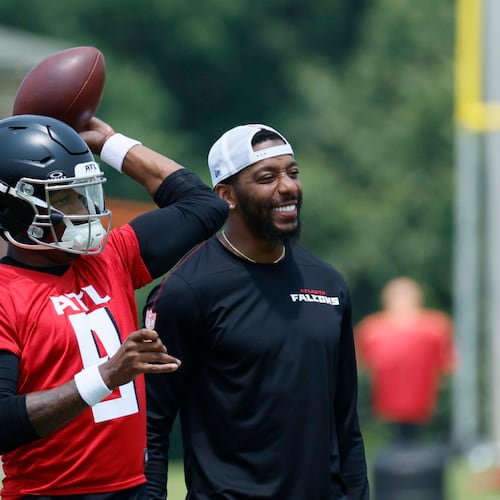Based on modern-era NFL history, replacing a legend of tight end Tony Gonzalez’ stature will be difficult to nearly impossible for the Falcons.
Here’s a look at how some other teams have fared trying to replace future first-ballot Pro Football Hall of Famers.
QUARTERBACK: Dan Marino, Dolphins
In 17 seasons with the Dolphins Marino set a lot of records and played in just one Super Bowl, a 38-16 loss to Joe Montana’s 49ers in Super Bowl XIX. Marino retired before the 2000 season and the Dolphins haven’t come close to the Super Bowl again (just one playoff win since) while suffering through a long series of bad quarterbacks.
Jay Fiedler got the unenviable job of following Marino. He started for most of his four seasons in Miami and owns the one playoff victory.
After Fiedler, A.J. Feeley, Gus Frerotte , Sage Rosenfels, Joey Harrington, Daunte Culpepper, Cleo Lemon, Trent Green, John Beck, Chad Pennington, Chad Henne, Tyler Thigpen, Matt Moore and Ryan Tannehill. Tannehill has shown some promise in two seasons, but the others can make some Dolphins fans long for Fiedler, who at least won a playoff game.
RUNNING BACK: Barry Sanders, Lions
Sanders was just 30-years-old when he suddenly retired after the 1998 season. He’d just been named to the Pro Bowl, his 10th selection in 10 seasons. Sanders was seemingly certain to break Walter Payton’s career rushing record — he needed just 1,458 yards and hadn’t missed a game in the previous five seasons.
Sanders later said he quit because he was tired of the team’s losing culture and had no desire to go through a rebuild. Detroit’s front office has proven him right. After making the playoffs in five of 10 seasons with Sanders, the Lions have been back just twice in the 15 years since he quit (wild-card losses during the 1999 and 2011 postseasons).
One reasons the Lions have been so bad post-Sanders is a long list of middling-or-worst running backs to succeed him. Ron Rivers was his initial replacement, rushing 16 times for 96 yards in a 28-20 victory over Seattle on Sept. 12, 1999. Greg Hill would finish the season as the team’s leading rushing with 542 yards on 144 carries. Since Sanders retired only James Stewart in 2000 and Kevin Jones in 2004 managed to top Sanders’ worst season of 1,115 yards.
WIDE RECEIVER: Jerry Rice, 49ers
Rice was already considered the game’s greatest wide receiver in 2000 at age 38. He’d depart the 49ers the next season and go on to play four more seasons with Oakland and Seattle.
The 49ers thought they had Rice’s successor in Terrell Owens, who’d been voted to his first Pro Bowl team in 2000. Owens would produce three more Pro Bowl seasons for the 49ers, but would develop a reputation for disruptive behavior. Worse, he didn’t measure up to Rice when it comes to what matters most in San Francisco: the 49ers won just one of three playoff games with Owens as the No. 1 receiver.
LINEBACKER: Lawrence Taylor, New York Giants.
Taylor was selected No. 2 overall in the 1981 NFL draft, shortly after the New Orleans Saints selected Duluth native George Rogers out of South Carolina. He went on to terrorize quarterbacks for 13 seasons. He was a 10-time Pro Bowl defender and eight-time first-team All-Pro pick. He had seven consecutive double-digit sack seasons, including 20.5 in 1986.
The Giants, with a long history of strong linebacker play dating to the great Sam Huff, opened the 1994 season with Michael Brooks and Corey Miller as their outside linebackers against Philadelphia on Sept. 4. The Giants finished with five sacks, but Miller and Brooks went sackless and despite being a team with consistent pass rush out of the defensive line, the team is always on the look for the next linebacker in the Taylor mode.
OFFENSIVE TACKLE: Anthony Munoz, Bengals.
Munoz was drafted third overall out of USC in 1980 by the Bengals. He went on to re-shape the left tackle position. He was an 11-time Pro Bowl player and was a nine-time first-team All-Pro selection. He started all 16 games eight times over his career. He was named to the NFL's 75th anniversary All-Time team.
He helped the Bengals reach the Super Bowl twice, XVI and XXIII, both were slim defeats at the hands of the San Francisco 49ers.
The Bengals were fading over his last two years in the league, but things went downhill fast after his retirement after the 1992 season. The Bengals reached the playoffs in 1990, but didn’t post a winning season and make the playoffs until 2005.
In 1993, the Bengals tried to replace Munoz with Kevin Sargent, who was an undrafted rookie free agent from Eastern Washington. He went on to play six seasons in the NFL but never reached the Pro Bowl and no left tackle since has been memorable.
About the Author
Keep Reading
The Latest
Featured



